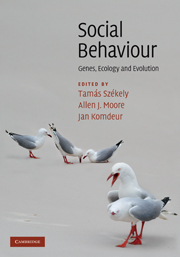Book contents
- Frontmatter
- Contents
- List of contributors
- Introduction: The uphill climb of sociobiology: towards a new synthesis
- Profile: Undiminished passion
- Part I Foundations
- Part II Themes
- 7 Aggression: towards an integration of gene, brain and behaviour
- Profile: From behavioural observations, to genes, to evolution
- 8 Social influences on communication signals: from honesty to exploitation
- Profile: Reputation can make the world go round – or why we are sometimes social
- 9 Important topics in group living
- Profile: A haphazard career
- 10 Sexual behaviour: conflict, cooperation and coevolution
- Profile: In celebration of questions, past, present and future
- 11 Pair bonds and parental behaviour
- Profile: Mating systems and genetic variation
- 12 Adaptations and constraints in the evolution of delayed dispersal: implications for cooperation
- Profile: Selections from a life in social selection
- 13 Social behaviour in microorganisms
- Profile: The de novo evolution of cooperation: an unlikely event
- 14 Social environments, social tactics and their fitness consequences in complex mammalian societies
- Profile: Evolutionary genetics and social behaviour: changed perspectives on sexual coevolution
- 15 Social behaviour in humans
- Profile: Genes and social behaviour: from gene to genome to 1000 genomes
- Part III Implications
- Species index
- Subject index
- References
10 - Sexual behaviour: conflict, cooperation and coevolution
Published online by Cambridge University Press: 05 June 2012
- Frontmatter
- Contents
- List of contributors
- Introduction: The uphill climb of sociobiology: towards a new synthesis
- Profile: Undiminished passion
- Part I Foundations
- Part II Themes
- 7 Aggression: towards an integration of gene, brain and behaviour
- Profile: From behavioural observations, to genes, to evolution
- 8 Social influences on communication signals: from honesty to exploitation
- Profile: Reputation can make the world go round – or why we are sometimes social
- 9 Important topics in group living
- Profile: A haphazard career
- 10 Sexual behaviour: conflict, cooperation and coevolution
- Profile: In celebration of questions, past, present and future
- 11 Pair bonds and parental behaviour
- Profile: Mating systems and genetic variation
- 12 Adaptations and constraints in the evolution of delayed dispersal: implications for cooperation
- Profile: Selections from a life in social selection
- 13 Social behaviour in microorganisms
- Profile: The de novo evolution of cooperation: an unlikely event
- 14 Social environments, social tactics and their fitness consequences in complex mammalian societies
- Profile: Evolutionary genetics and social behaviour: changed perspectives on sexual coevolution
- 15 Social behaviour in humans
- Profile: Genes and social behaviour: from gene to genome to 1000 genomes
- Part III Implications
- Species index
- Subject index
- References
Summary
Overview
In sexually reproducing species, individual fitness is ultimately determined by social interactions over mating and fertilisation among rival members of the same sex and between prospective partners. Variation in the competitive ability to secure reproductive opportunities generates sexual selection, which promotes traits that confer a reproductive advantage in intrasexual competition through combat, scramble, courtship or manipulation, and which may benefit or harm members of the opposite sex. The ensuing intra- and intersexual coevolutionary dynamics often drag phenotypes away from naturally selected optima, producing the spectacular exaggeration that has captured the interest of generations of biologists. In this chapter, we first illustrate how the evolution of differential gametic investment by males and females (anisogamy) sets the scene for sexually dimorphic strategies and, ultimately, determines the intensity of evolutionary conflict between the sexes. In particular, we focus on intra- and interlocus sexual conflicts and their profound but poorly understood repercussions for intersexual coevolution. Second, we outline the principles of sexual selection theory, focusing on their implications for the evolution of sexual behaviour. Finally, we conclude by identifying future directions for the evolutionary analysis of sexual behaviour.
Introduction: sexual behaviour as a social trait
The lifetime reproductive success, or fitness, of an individual is measured by the representation of its genes in the gene pool of the next generation. In sexually reproducing species, individual fitness reflects the number of zygotes produced by an individual over its lifetime, and – indirectly – the ability of these zygotes to develop and reproduce.
- Type
- Chapter
- Information
- Social BehaviourGenes, Ecology and Evolution, pp. 230 - 266Publisher: Cambridge University PressPrint publication year: 2010
References
- 6
- Cited by



